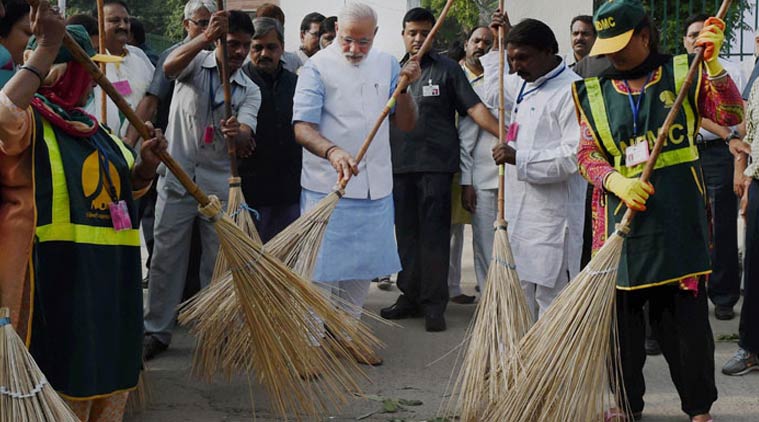Swachh Bharat has initiated a behavioural change that seems irreversible
Latest data shows that the Swachh Bharat Mission has initiated a behavioural change in most parts of the country. It seems irreversible.

A half-empty glass versus a half-full glass — that’s a clichéd expression. Typically, where is the glass located, when you glance at it? More often than not, it is on a table of some sort, below your line of vision. Therefore, your eye focuses on the empty bit. I wonder how we would react if the glass is placed above our line of vision, so that we look at it from the bottom, rather than the top. This strikes me as an apt analogy because of a recent incident.
An acquaintance had dropped in, to complain and lament about cabbages and kings. This is the time of the year when assorted diaries surface. Increasingly, people don’t use such diaries, but old habits die hard. There is a beautiful diary (and an accompanying calendar) brought out by the Ministry of Drinking Water and Sanitation, with a focus on the Swachh Bharat Mission (SBM), especially on its gramin (rural) part. SBM was started on October 2 2014. A little bit about SBM’s dashboard first. Since October 2014, 91.5 million toilets have been constructed and 154.3 million rural households have toilets now. Goa and Odisha, however still lag behind. Barring these two states, IHHL (individual household latrine application) coverage in all states is in excess of 95 per cent (Telangana is marginally less). By October 2019, coverage should be universal. So what? Toilets have been built. However, households don’t use them. However, that’s not what the 2017-18 National Annual Rural Sanitation Survey tell us. Conducted independently by the World Bank, the survey found that 77 per cent of households (between November 2017 and March 2018) had access to toilets (not the same as possessing individual household toilets) and 93.4 per cent of people who had access to toilets used them. There is some emptiness, but it is a sliver.
Five hundred and eighty four districts, 5,840 blocks, 244,687 gram panchayats and 541,433 villages are open defecation free (ODF). ODF coverage is still low in Goa, Odisha, Bihar, Telangana and Tripura but there is time till October 2019. A declaration means nothing. Shouldn’t there be some verification? Precisely. Out of the 541,433 villages declared as ODF, 438,342 have been verified to be ODF. What happens if they slip back thereafter? There can be a two part answer. First, that the 2017-18 survey again shows only a sliver of emptiness — 95.6 per cent villages declared and verified as ODF continued to remain ODF. There is some slippage, but not as much as one might have thought. Second, behavioural change confronts the bane of inertia, reminding us of Newton’s Second Law of Motion. We do need an externally imposed force to change the state. That might be through films like Toilet, Halkaa or Gutrun Gutargun. Or that change might come from swachhagrahis. The diary has 12 lovely cartoons. One of these is on swachhagrahis. The diary tells us “swachhagrahis are the foot soldiers of the Swachh Bharat Mission. Over the last four years, a cadre of 500,000 swachhagrahis has been created who have triggered lakhs of villages to become ODF.” My acquaintance hadn’t heard of swachhagrahis until he flipped through the diary on my table. He was so engrossed in lamenting about interest/exchange rates, ships and sealing wax that he had failed to notice a silent revolution sweeping through rural India.
Let me quote from the July 2018 circular on revised guidelines for swachhagrahis. “As you are aware, Swachh Bharat Mission (Gramin) [SBM (G)] emphasises on intense behaviour change campaigns including inter-personal communication for achieving sustainable sanitation outcomes. Swachhagrahis are the foot soldiers of the SBM (G) and the motivators for bringing about behaviour change with respect to key sanitation practices in rural areas. Role of swachhagrahis is one of the key factors in achieving the ODF status and sustaining it through post ODF activities. A swachhagrahi is a volunteer who can come from any background, including a local ASHA worker, ANM, anganwadi worker, and staff, water line man, pump operator, member of NCO/CSOs, youth organisations or from the general public living in villages.” Beyond the obvious, there are several things swachhagrahis do – geo-tagging toilets, verifying household behaviour, converting old toilets and retro-fitting them, engaging in other forms of cleanliness.
I am also struck by the swachhagraha movement in schools and swachhagrah preraks (teachers). This is an Adani Foundation initiative in 5,337 schools in 80 cities. (You should read up the case studies.)
All this has a bearing on Sustainable Development Goal 6.2: “By 2030, achieve access to adequate and equitable sanitation and hygiene for all, and end open defecation, paying special attention to the needs of women and girls and those in vulnerable situations.” There are references to India where open defecation figures prominently and many households are mentioned as not having access to toilets. For instance, World Bank reports for 2015 note that 40 per cent of the Indian population resorts to open defecation. This is an official World Bank figure. And, a December 2018 paper, co-authored by World Bank researchers states, “A staggering 48 per cent of Indians continue to defecate in the open despite large?scale efforts from the government to raise awareness about the harmful aspects of open defecation and subsidise latrine construction, and growing latrine ownership. This is a formidable challenge since almost 70 per cent of rural Indian households currently do not have access to improved sanitation facilities.” The reason for apparently contradictory numbers is obvious — cross-country data quoted is often for 2015. However, the level of the table has been raised up. We can look at the glass from below and not from the top.
— This article first appeared in the January 10, 2019 print edition under the title ‘Silent revolution in the countryside’






































No hay comentarios:
Publicar un comentario